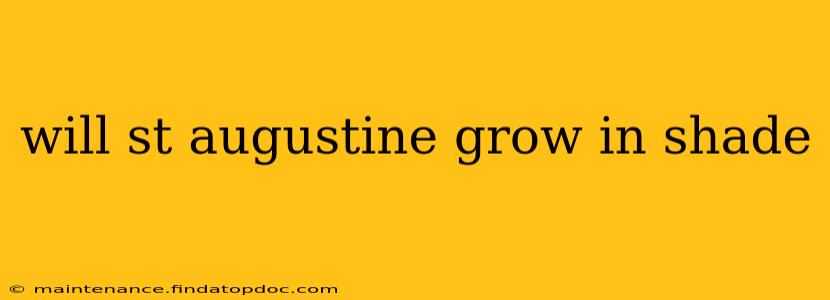St. Augustine grass, known for its lush green blades and resilience, is a popular choice for lawns across the Southern United States. However, its love for sunshine raises a common question: Will St. Augustine grass grow in shade? The short answer is yes, but with caveats. Its growth and health are significantly impacted by the amount and type of shade it receives. This guide delves into the specifics, exploring the factors that influence its growth in shaded areas and offering tips for success.
How Much Shade Can St. Augustine Grass Tolerate?
St. Augustine grass thrives in full sun, meaning at least six hours of direct sunlight daily. While it can tolerate some shade, prolonged periods of deep shade will significantly hinder its growth. Think of it this way: light shade, like that provided by a lacy tree canopy that allows dappled sunlight to filter through, is generally acceptable. However, dense shade from tall buildings or dense foliage will likely lead to problems.
What Happens to St. Augustine Grass in Shade?
When deprived of sufficient sunlight, St. Augustine grass undergoes several changes:
- Weakened Growth: The grass will grow more slowly, leading to a thinner, less lush lawn.
- Increased Susceptibility to Disease: Shade creates a damp environment, making the grass more vulnerable to fungal diseases and other pathogens.
- Increased Weed Growth: Weak, shaded St. Augustine grass struggles to compete with weeds, leading to an overrun lawn.
- Thinning and Dying: In extremely shady areas, the grass may thin out considerably or even die off completely.
Can I Grow St. Augustine Grass in Partial Shade?
Yes, you can grow St. Augustine grass in areas with partial shade, but it's crucial to understand the limitations. "Partial shade" generally refers to areas that receive at least four hours of direct sunlight daily. Even with partial shade, you may notice the grass isn't as vibrant or dense as in full sun. Proper fertilization and watering are even more crucial in these situations.
What Types of Shade Affect St. Augustine Grass the Most?
The type of shade significantly impacts St. Augustine's growth. Light, dappled shade from deciduous trees (those that lose their leaves in winter) is far less problematic than dense shade from evergreen trees or buildings. Deciduous trees allow more sunlight penetration during the dormant months when the leaves are off the branches. Dense shade, however, limits sunlight penetration year-round.
How Can I Improve the Growth of St. Augustine Grass in Shade?
While St. Augustine grass isn't ideal for deep shade, you can take steps to improve its performance:
- Choose a Shade-Tolerant Variety: Some St. Augustine grass cultivars exhibit slightly better tolerance to shade than others. Research options known for better shade tolerance before planting.
- Proper Soil Preparation: Ensure your soil is well-drained and amended with organic matter to improve nutrient availability.
- Fertilization: Use a fertilizer specifically formulated for St. Augustine grass, and adjust the application schedule according to the level of shade.
- Watering: Water deeply but infrequently to promote strong root growth. Avoid overwatering, which can exacerbate disease problems in shady areas.
- Weed Control: Regular weed removal is vital to minimize competition for resources.
Will St. Augustine Grass Grow Under Trees?
The answer depends on the type of tree. Under deciduous trees that provide light dappled shade, St. Augustine grass can often survive and even thrive with proper care. However, under evergreen trees or those with dense canopies, the lack of sufficient sunlight will likely lead to poor growth and increased disease susceptibility.
Is It Better to Replace St. Augustine Grass With a Shade-Tolerant Alternative?
In areas with significant, persistent shade, replacing St. Augustine grass with a more shade-tolerant alternative is often the best option. Several grasses are better suited for shaded conditions, so consider these alternatives if St. Augustine is struggling. Consulting with a local landscaping professional can help you choose the best grass for your specific conditions.
This detailed guide offers a comprehensive understanding of St. Augustine grass growth in shade, providing valuable insights for homeowners aiming to maintain a healthy lawn even in partially shaded areas. Remember that consistent monitoring, proper care, and potentially considering alternative grass types are essential for success.
